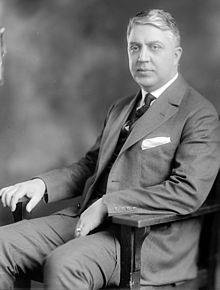Harry L. Davis
Harry L. Davis | |
|---|---|
 | |
| 49thGovernor of Ohio | |
| In office January 10, 1921 – January 8, 1923 | |
| Lieutenant | Clarence J. Brown |
| Preceded by | James M. Cox |
| Succeeded by | A. Victor Donahey |
| 38th and 44thMayor of Cleveland | |
| In office 1916–1919 | |
| Preceded by | Newton D. Baker |
| Succeeded by | William S. Fitzgerald |
| In office 1934–1935 | |
| Preceded by | Ray T. Miller |
| Succeeded by | Harold Hitz Burton |
| Personal details | |
| Born | Harry Lyman Davis January 25, 1878 Cleveland,Ohio,U.S. |
| Died | May 21, 1950(aged 72) Cleveland,Ohio,U.S. |
| Resting place | Lake View Cemetery,Cleveland, Ohio,U.S. |
| Political party | Republican |
Harry Lyman Davis(January 25, 1878 – May 21, 1950) was anAmericanpoliticianof theRepublican Party.He served as the 38th and 44thmayorofCleveland,Ohioand as the 49thgovernor of Ohio.[1]
Life and career
[edit]Davis was born inCleveland, Ohioon January 25, 1878 in the Newburgh area to Evan and Barbara Jones Davis. He was of English and Welsh ancestry, all of his ancestors having emigrated toNorth AmericafromGreat Britainduring the era of theThirteen Colonies.[2]At age thirteen, he left school to work in the steel mills, studying at home and night school. He became a solicitor for the Cleveland Telephone Co. at age twenty-one and later founded the Davis Rate Adjustment Co., selling telephone securities and the Harry L. Davis Co., selling insurance.[1]
In 1909, Davis was elected Republican city treasurer. David defeated his opponentPeter Wittin the 1915 Cleveland mayoral election. As the city's new mayor, Davis established the Mayor's Advisory War Committee in 1917 to aid the American effort inWorld War I.As mayor Davis reached out to and supported immigrant ethnic communities in Cleveland. The Polish-American community voted for him "almost unanimously" in his 1915 mayoral election and supported him throughout the rest of his political career. He was known for being sensitive to the concerns of Polish immigrants and Italian immigrants in Cleveland.[3]His work gained national recognition. Mayor Davis also had to deal with the communistMay Day Riots of 1919and the bombing of his home by communist agitators; theRed Scarepresented a new set of dilemmas. Davis responded to the outrages by campaigning for the expulsion of all "Bolsheviks" from America.[4]Since 1919 was an election year, Davis resigned from the mayor's office and went on to successfully campaign for governor of Ohio. TheCommunist Party USAand theSocialist Party of Americaboth unsuccessfully campaigned against him.[5]
Davis won the governor's seat and served one term. While in office, Davis restructured the executive branch to include a cabinet of seven directors to help administer state affairs. Davis did not run again in 1922, but rather 1924, when he was soundly defeated by incumbentA. Victor Donahey.Davis later returned to Cleveland and became a strong opponent of thecity managerplan. He later served again as mayor from 1934 to 1935.
Death
[edit]In his later years, Davis suffered from frequent periods of ill health.[6]He died at his home in Shaker Heights, Ohio, on May 21, 1950, soon after he was stricken with a blood clot in the brain.[7]He was buried atLake View Cemeteryin Cleveland.[1][8]
References
[edit]- ^abc"Harry L. Davis, 72, Ohio Ex-Governor. State Chief Executive, '21-23, Dies. Former Steel Worker, Cleveland Mayor 4 Terms".The New York Times.May 22, 1950.
- ^Red Scare: A Study in National Hysteria, 1919-1920 by Robert K. Murray Greenwood Press, 1980
- ^Polish Americans and Their Communities of Cleveland by John J. Grabowski - 1976
- ^"Cleveland Proposes to Deport All Reds"(PDF).The New York Times.New York, NY. June 5, 1919. p. 2.
- ^Red Scare: A Study in National Hysteria, 1919-1920 by Robert K. Murray Greenwood Press, 1980
- ^"Harry Davis, Governor In '21-'23, Dies".The Journal-Herald.Dayton, OH. Associated Press. May 22, 1950. p. 1 – viaNewspapers.com.
- ^"Harry L. Davis Dies Suddenly".The Plain Dealer.May 22, 1950. pp. 1, 3.
- ^"Last Rites For Harry L. Davis".The Massillon Evening Independent.May 24, 1950. p. 1.RetrievedApril 2,2017.
Further reading
[edit]- The Encyclopedia Of Cleveland Historyby Cleveland Bicentennial Commission (Cleveland, Ohio), David D. Van Tassel (Editor), and John J. Grabowski (Editor)ISBN0-253-33056-4


